|
|
|
|
The Down to Earth Woodworker
By Steven D. Johnson
Racine, Wisconsin
|
|
This Month's Column:
•
Stuffed With Leftovers
•
Custom Clamping Cauls
Stuffed With Leftovers
Click on any picture to see a larger version.
By now all of your gift-projects are probably (hopefully) completed, needles are beginning to fall from the tree in copious quantities, the recycling bin is full of gift wrap and ribbon, not to mention cardboard and assorted other packing material, and if you are of the Clark Griswold ilk, you may even be contemplating braving the cold and dismantling the strings of lights and robotic reindeer adorning your house. For a lucky bunch of woodworkers, you are likely playing with new "toys" you got for Christmas and learning how to use a new jig or doo-dad, or perhaps contemplating how to spend that spanking new
Highland Woodworking gift certificate
burning a hole in your wallet. You are also likely to still be trying to consume all those leftovers in the fridge and if you are anything like me, you've already grown tired of turkey sandwiches.
With the pre-season gift-making panic past, you may now also be feeling a bit of post-season claustrophobia. It happens. In the mad dash to get all those holiday gifts finished, your workshop probably looks like a storm hit and all that's left behind are heaps, stacks, bins, boxes, and bags full of scrap wood… leftovers of the woodworking kind. And just like the turkey and apple pie, these leftovers are just too good to throw away.
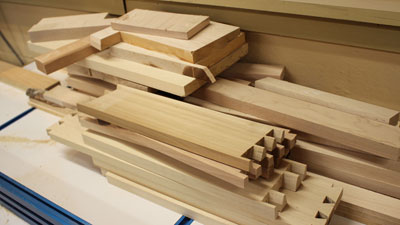
|
Figure 1 - Most of my scrap starts off being tossed in a pile on the back side
of my miter saw station
|
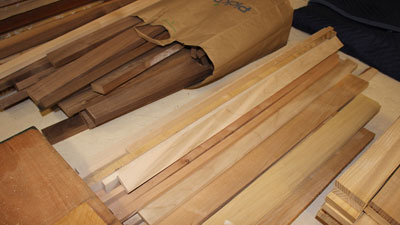
|
Figure 2 - When that pile gets too big, it gets moved to stacks in out-of-the-way
corners of my shop...
|
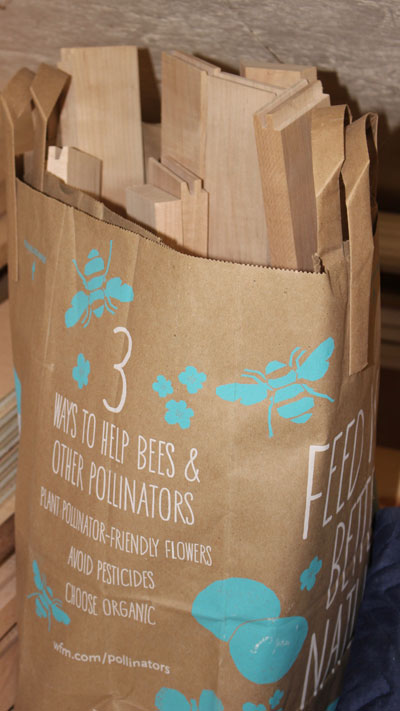
|
|
Figure 3 - ...or put in old shopping bags
|
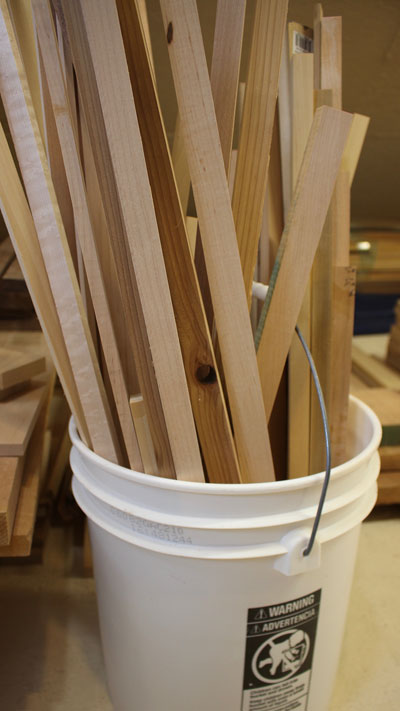
|
|
Figure 4 - ...or buckets
|
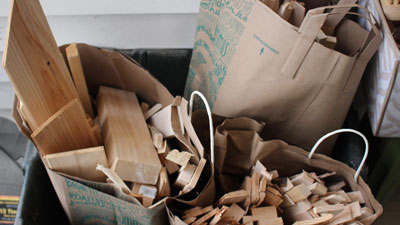
|
Figure 5 - ...or even more bags sitting just outside my shop door...
whew, that's a lot of scraps!
|
So before you make a bonfire or dump all your scraps into the fireplace, consider whether some scraps can be used for smaller projects. And don't just "save" them… use them. Now! Because if you procrastinate, all those beautiful scraps will be in your way all year. Remember, throughout the year you will continue to add to the heap, only making things worse.
The first step toward organized and orderly consumption of scrap is to sort the pieces by species. Some pieces are pretty easy to identify… some take a bit more scrutiny. It's pretty easy to tell maple from walnut, and there is no chance of mixing up ash and zebrawood, but cherry can be a bit deceptive lurking in a pile mixed with poplar, pine, and ash. Sometimes canary wood can fool you, and oak isn't as easy to distinguish as you might think. So it is not uncommon to have one stack of "unknowns" that requires further examination. So clear a big space on the floor or on a work table and start making piles.
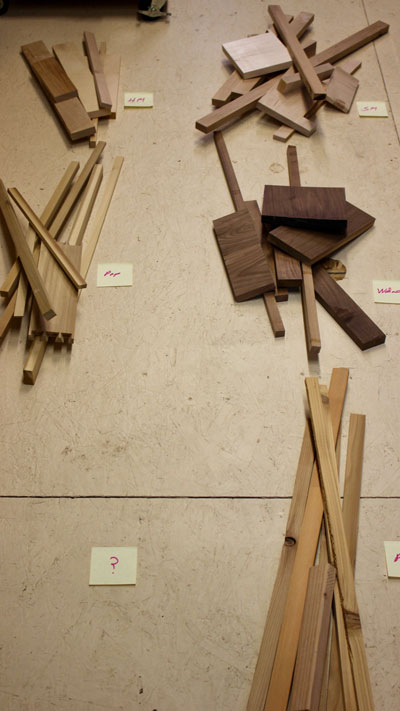
|
Figure 6 - Just starting the sorting process...
sticky notes work well to label the piles
|
In the process of sorting, a few pieces are clearly out of place and can be tossed in the garbage. "How did that scrap of plywood get into this stack of maple?" Then there are the pieces that are really ugly… "The end of that board was cut off for a reason, why did I save it?" And some pieces are simply too small for anything… those can go into a "kindling" box, great for getting the fireplace going, or (yikes) into the trash if you don't have a fireplace or wood stove.
Once sorted by species, the stacks of leftovers are actually huge piles of potential. In years past I've made small picture frames, cutting boards, coasters, plate display stands, carved knickknacks, coat hooks, and toys… I've turned some pieces into pegs (back when I was on a Mission Style kick) and I've even given a few choice pieces to woodturning friends who make pens. Some pieces will make decent reinforcement blocks, wooden table top attachment blocks, corner braces, drawer stops, and, if nothing else, a few pieces will serve well as clamp pads. Don't forget to save a few pieces to use when testing a new finish or determining a shade of shellac for a project.
Once the pieces are sorted by species, it may be necessary or desirable (depending on how big each pile is) to do a further sort, this time by general size. In my shop, the sheer quantity of leftovers makes "size" sorting critical. You can do this a variety of ways, but this is the perfect time to have some ideas about how you intend to use the scraps.
To consume left-overs I always make cutting boards. They are relatively fast to make, easy, and greatly appreciated by all who receive them. So I sort out pieces big enough for respectable cutting boards in one pile. Medium size pieces you might consider too small for a cutting board make great cheese boards, certainly always an appreciated gift here in Wisconsin where cheese is not just consumed in copious amounts, but celebrated. All of the "left-over" left-overs, the really small stuff, is put in a separate pile. One interesting phenomenon that you may experience during the "size sorting" step is that you will get a bit more discriminating the second time you go through a batch of scrap and a few more pieces will go into the "burn" pile and a few more will go into the trash.
Once all the scraps are sorted, it is imperative that they be used right now. Don't procrastinate! Here is a trick to prevent that "I'll do it later" attitude and that will virtually "force" you into making something useful out of all the pieces… put the stacks, piles, and boxes of sorted material around your shop where they are absolutely in your way. Really. Now when you are tempted to play with a new woodworking "toy" you received as a gift or spend a few hours online trying to figure out how to stretch your gift certificate just a little further, stepping over, around, and through the piles of scrap will get you focused and get you back to work.
A tiny word of caution. If you normally build smaller scale projects you already know this, but if you generally build larger projects, like I do, working with small pieces can be challenging and dangerous. I fuss a lot about heaving giant boards up to the table saw, but I have rarely had "incidents" when working with bigger pieces of wood. Smaller pieces, have, however, given me more than a fair share of adrenaline rushes. Small pieces, by their nature, force you to place precious fingers closer to cutting blades. Use appropriate
push blocks
, guards, and other helpers to get the work piece close to the cutters while keeping your hands a safe distance away. Smaller pieces are more likely to kick back from planers, so use sleds or send pieces through touching end-to-end (also helps alleviate snipe). If you have a
drum sander
, now might be a good time to experiment with thicknessing those small pieces by sanding rather than planing. Small pieces on the router table can be troublesome. A
Wooden Handscrew Clamp
is great for holding pieces while routing. The same trick can be used at the bandsaw.
Tackle the leftovers in your shop right now before you start on your next big project. A little post-holiday diligence will pay off in a cleaner, more spacious shop for the New Year and beyond. And who knows? You might just make so many scrap-wood projects that all your gift-giving projects for next year will be done… way ahead of time. Imagine a relaxing November and December with no last minute panic! Now, let me get back to the
Highland Woodworking website
and figure out how to spend my gift certificate…
(Page 1 of 2)
1
2
Next Page

Steven Johnson is retired from an almost 30-year career selling medical equipment and supplies, and now enjoys improving his shop, his skills, and his designs on a full time basis (although he says home improvement projects and furniture building have been hobbies for most of his adult life). Steven can be reached directly via email at
sjohnson@downtoearthwoodworking.com
Return to the
Wood News Online
front page
|
|
|
|
|